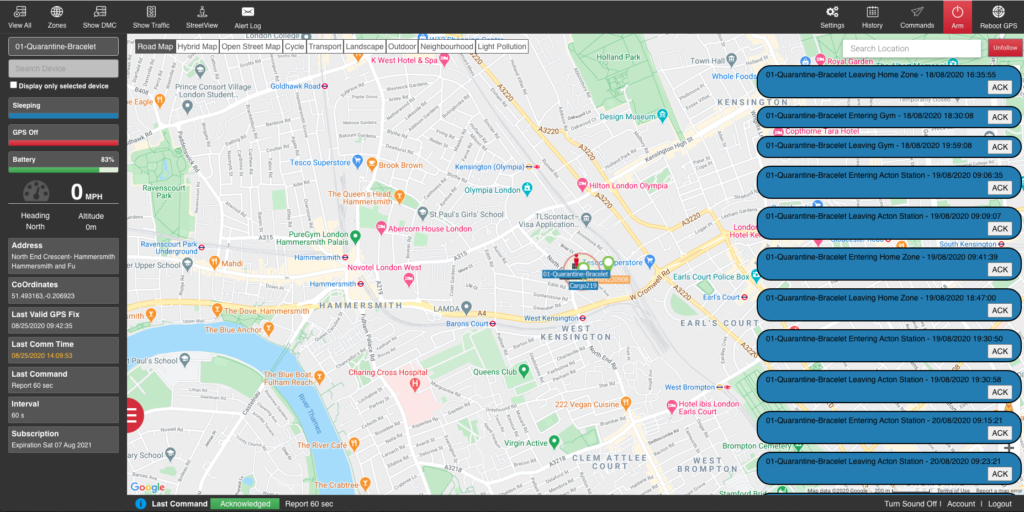One of the most challenging aspects of the Covid-19 pandemic has been the monitoring of populations during quarantine restrictions. The unprecedented spread of coronavirus globally means robust systems are needed to monitor the location of infected people, plus anyone else they come into contact with. Without adequate quarantine measures in place, the virus can quickly spread, leading to local lockdowns and subsequent economic damage to businesses and livelihoods.
A Solution For Repeat Quarantine Offenders?
While most governments would prefer to control the virus without the use of severe restrictions, there are some situations where monitoring technology could prove beneficial. Individuals or groups who continually fail to comply with quarantine orders may be prime candidates for dedicated Covid-19 quarantine monitoring technology such as the solution offered by findwear.com This is especially true if healthcare ‘track and trace’ schemes prove ineffective and the virus begins to spread more rapidly.
A requirement for innovative quarantine monitoring technology is evident with the many cases of repeat offending being seen worldwide. In August 2020, the BBC reported how an Australian individual was caught flouting quarantine rules and jailed after crossing state boundaries and isolating in her partner’s home. In this case, the use of modern tracking technology would have reduced the expense of trial and jail while ensuring compliance with lockdown rules.
ABC News reported another case on 30 July 2020 in Miami, U.S., where a Florida couple were jailed for refusing to quarantine after testing positive for the virus. The couple in their 20s repeatedly broke restrictions by travelling outside of their home, increasing the risk of widespread infection. This is just another instance where dedicated quarantine monitoring technology might have proved helpful.
Realtime Alerting Of Quarantine Exceptions

One example of the type of Covid-19 quarantine monitoring technology is a customized version of existing offender tracking technology. Such a tracking system would need to be able to record the movement of wearers to ensure they remain in their defined ‘homezone’. The device would also need the functionality to record violations and report these to relevant parties in the event the individual strays outside of their predefined area. And should the wearer have the intention to remove the tracker, it must also have a tamper feature that alerts authorities, similarly to ankle bracelets used by criminals as an alternative to jail.
Needs for A Cost Effective But Functional Technology Stack

To be functional and effective, quarantine monitoring technology must be compatible with all popular global satellite navigation systems. These include GPS, GLONASS, Galileo, and Beidou. An internal cellular data modem would also be needed, with a 4G or LTE ‘low power’ connection and internal high gain antennas for the transmission of data across distances. A battery of at least 800 mAh would provide battery life for at least 14 days – the de facto standard for quarantine during the coronavirus outbreak. Other technologies like Bluetooth could even be implemented to add increased accuracy. For more information on a suitable GPS tracking ankle bracelet visit www.findwear.com
Friendly, Comfortable Form for Design

Design is as equally important a consideration as technology and functionality. The device would need to be comfortable for the wearer yet robust enough to prevent removal or damage during the quarantine period. It would also require adjustable straps or another mechanism to fit different body types. The casing should be IP67 rated so it is waterproof for the outdoors and can be used in the shower. Theoretically, the smaller the device, the greater comfort and level of compliance would likely be.
Would You Wear a Quarantine Monitoring Tracker?
Monitoring devices could prove advantageous as a last resort for persistent quarantine offenders. But they are only likely to be used in severe circumstances. One example is if the virus is extremely difficult to manage or there is demand for such an approach to deter repeat offenders. The ethical and privacy considerations are important to consider, as is the use and storage of tracking data.
There are also cost issues to consider, especially when budgets are largely being directed towards healthcare and potential treatments and cures for the virus. The widespread viability of the system, not to mention the logistical challenge of rollout means governments across the world may lean towards measures like fines. That said, the technology exists to create effective quarantine monitoring technology. But whether governments will implement and scale it for widespread use is another story.